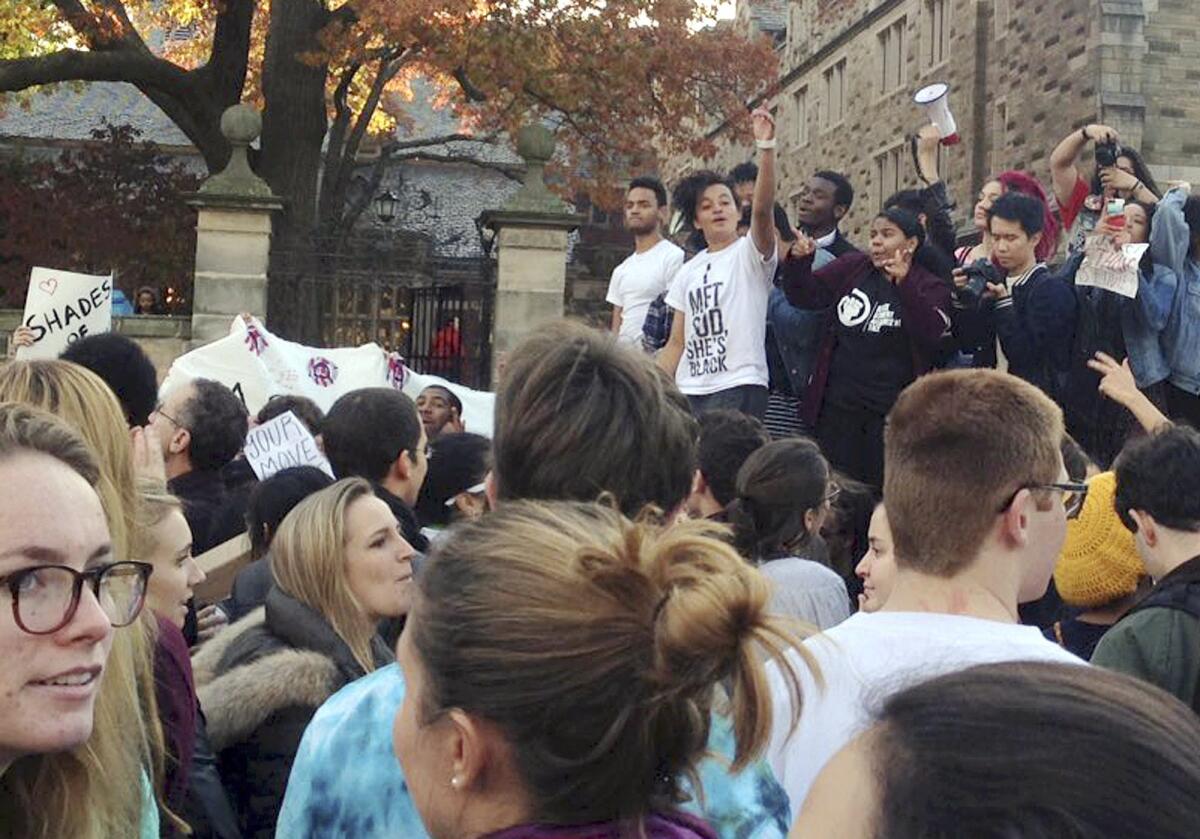Column: The tantrums at Mizzou and Yale reveal more than PC problems

Yale University students and supporters participate in a march across campus at the Ivy League school on Nov. 9, in New Haven, Conn.
- Share via
At the University of Missouri, it took a hunger-striking student and the threat of a football boycott to get the president and chancellor to step down amid long-standing campus racial tensions.
At Yale, it took a viral YouTube video of an angry student upbraiding a faculty member to get the university’s president to say “We failed you” to a group of minority students upset about their own campus’ racial tensions.
Though Yale doesn’t have quite the same troubled racial legacy that Missouri does, the ferment has been a long time coming there too. A black female student says she was turned away from a fraternity party that welcomed “white girls only.” Then lecturer Erika Christakis generated outrage when she sent an email suggesting that an advisory about avoiding offensive Halloween costumes (such as turbans or feathered headdresses) might be politically correct overkill.
It was a carefully worded, well-intentioned missive, but that didn’t matter. Christakis and her professor husband, physician and sociologist Nicholas Christakis, live among the students at one of Yale’s residential colleges. As a college “master” and “associate master,” the Christakises (according to the Yale website) are “responsible for the physical well-being and safety of the students” (a tall order, but that’s a topic for another day). When Nicholas Christakis defended his wife to a group of angry students, saying something about fostering an “intellectual space,” one young woman swore at him with astonishing vehemence and told him he should leave his job. As with many viral videos, you want to look away, but that’s the very reason you can’t stop watching.
Before ubiquitous camera phones, this might have been little more than an extreme example of “lively student-faculty dialogue.” Before citizen journalism and blog-driven character assassination, a student who yelled at Christakis might enjoy 15 minutes of campus notoriety, cult status among a small group of activists and, possibly, a lifetime of class reunions at which people ask “Isn’t that the girl who cursed at a professor?”
As it is, the exchange became the latest low-hanging fruit for a commentariat obsessed with campus political correctness. As it is, the young woman has reportedly received death threats, and her online existence has been mined for personal details. The Daily Caller giddily disclosed that she came from a wealthy town, the implication being that regardless of color, ethnicity or anything else, she cannot legitimately feel discriminated against.
I’m a member of the aforementioned commentariat, and I admit to getting a fruit-sugar rush from this kind of story. Elite college students who demand safe spaces because they can’t seem to distinguish dissenting opinions from personal attacks tend to elicit mockery and opprobrium from liberal and conservative journalists alike. It creates a kind of sinister kumbaya feeling that’s strangely satisfying.
Still, the Yale student doesn’t deserve death threats. She doesn’t even deserve public shaming. Her behavior was inappropriate, but a lot of people say and do stupid things in college. Reason and restraint are sometimes no match for supercharged emotions when you’re 19, 20 or 21, and those lucky enough to be at a residential college during those years are sometimes given the impression that nothing they do — good or bad — really counts yet.
That doesn’t excuse shouting full-tilt profanity at an authority figure. But there is also no excuse for the media’s taking delight in pillorying students for their special snowflakedom and dismissing the very real problems their tantrums may actually reveal.
In one such excoriation, the Wall Street Journal expressed doubt that “someone with a Yale degree could be marginalized in society.” That might have been true back when the Ivies were almost exclusively bastions of blue-blood privilege. But the demographics have changed. More than half of Yale’s undergraduates receive need-based financial aid; 9% identify as black or African American; another 9% as “Hispanic of any race.” Fourteen percent of the class of 2019 are the first in their families to go to college.
In other words, while there are still many for whom an Ivy League education serves as finishing school, there are plenty of others for whom it’s a starting point that doesn’t preclude isolation and struggle. Such difficulty isn’t ultimately a matter of Halloween costumes. It’s about, among other things, the lack of a racially mixed faculty or the pervasive sense that students of color must shoulder the task of representing their entire race. It’s about managing the growing pains that go along with steering historically homogenous institutions toward the diverse future.
At Missouri, the stakes were clear. Striking football players meant at least a million-dollar fine. That proved a serious-enough threat to force the sacrifice of a college president and a chancellor.
At Yale, the protests, like many of the aggressions themselves, are more micro, sometimes even a bit ridiculous-sounding when weighed one by one. But that doesn’t mean they don’t add up to something that feels macro. The question is, can we find a way to make intellectual spaces and safe spaces one and the same?
Twitter: @meghan_daum
Follow the Opinion section on Twitter @latimesopinion and Facebook
More to Read
A cure for the common opinion
Get thought-provoking perspectives with our weekly newsletter.
You may occasionally receive promotional content from the Los Angeles Times.











